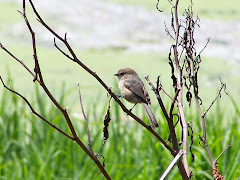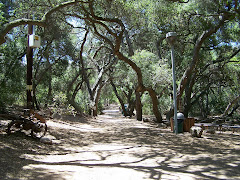
Male Redhead at small, private "lake" or pond in Orange County
One of the least common ducks in North America (according to the USGS), the male Redhead is striking and easy to spot. It has a dark red head, black chest, gray back and a black tail end. Its eyes are a bright yellow. Its bill is bright blue, ending with a indistinct pale stripe and a black tip. The female also has the same indistinct pale stripe and a black tipped bill, but her bill is more grayish-blue. (Bill is similar in pattern to the Ring-necked Duck.) Their feet are blue-gray with the males having brighter feet than the females. The female Redhead is brown with a white eye ring. Her eyes are brown. During the molting season, the male's head temporarily becomes less red. As in many species, the immature closely resembles the female. The females weigh less than the males, but otherwise are the same size. According to the USGS, the oldest recorded age for a wild Redhead is just a few months over 22 years old.

Male and Female Redheads at Irvine Regional Park in Orange, California background and Ring-necked Ducks in foreground.
Redheads are crepuscular (occurring at dawn and dusk) and nocturnal feeders. They combine diving and dabbling feeding styles, but are primarily diving ducks. They feed on almost entirely on plant matter including wild celery, wetland grasses, and the leaves, roots, seeds, and stems of aquatic plants. A small amount of their diet consists of fish, insects, and other aquatic life. During breeding season, before laying eggs, the female switches to a mostly animal based diet.
 Male Redhead at Bolsa Chica Ecological Reserve
Male Redhead at Bolsa Chica Ecological ReserveRedheads are at home in either salt water or fresh or anywhere in between. They dive and dabble in the water. They can be found in lakes, bays, estuaries, and ponds. Habitat loss is cited as the reason experts believe this species has declined. It is hopeful to note that the population of Redheads in North American appears to be increasing.
 Male Redhead with Male Scaups at Bolsa Chica Ecological Reserve
Male Redhead with Male Scaups at Bolsa Chica Ecological ReserveRedhead females are often the initiator in courtship, but not always. Sometimes they string two males along until the males clash and one leaves. Courtship begins in late winter and by late April the eggs are beginning to be laid. After the eggs are laid, the male takes off. Females often lay their eggs in the nests of other Redheads, other duck species or the nest of any handy species. They have even been know to lay eggs in the nests of American Bitterns and Northern Harriers both of whom nest on the ground. Breeding season lasts until late June. Nests close together.
 Male Redhead at Bolsa Chica Ecological Reserve
Male Redhead at Bolsa Chica Ecological ReserveRedheads breed in Alaska, the southern part of Canada, and in the northern part of the lower 48 States. They winter from California and along the Gulf of Mexico and south into Mexico.
 Male and Female Redheads at Bolsa Chica Ecological Reserve
Male and Female Redheads at Bolsa Chica Ecological Reserve Similar species are the Canvasback, and the Ring-necked Duck. The Ring is shaped similarly, but is black, white, and gray with no red. The bill is a lighter shade of blue.
 Male Canvasback
Male Canvasback  Male Redhead at small private lake or pond in Orange County
Male Redhead at small private lake or pond in Orange CountyRedheads tend to move around in flocks. Like Cedar Waxwings, or Cattle Egrets, they can turn up unexpectedly.
 Male Redhead at small private lake or pond in Orange County
Male Redhead at small private lake or pond in Orange CountyFemale Redheads have a harsh sounding quack. The male "meows" during courting.
Redhead - Delta Waterfowl Species Profile on YouTube

Male Redhead at small private lake or pond in Orange County
The Redhead is a very pretty bird and a nice one to see. Next time you are near water, scan the lake, pond, or estuary for this handsome duck, and have fun birding in Orange County.
Below are some videos I took of the Redhead at the private lake or pond in Orange County.
Redhead--Aythya americana II from OC Birder Girl on Vimeo.
Interesting information regarding the population of Redheads in the United States.
BirdWeb: Redhead
Helpful.
Honolulu Zoo: Redhead
Detailed profile.
Home - Index - Contact - Shop - Ask the OC Birder Girl - OC Birder Girl Videos



































 Male Northern Harrier flying low over the water. Notice his gray and white coloring. Notice that his long legs hanging down.
Male Northern Harrier flying low over the water. Notice his gray and white coloring. Notice that his long legs hanging down.








